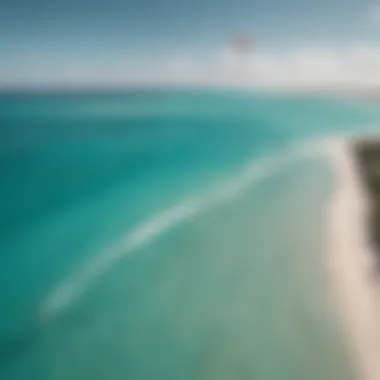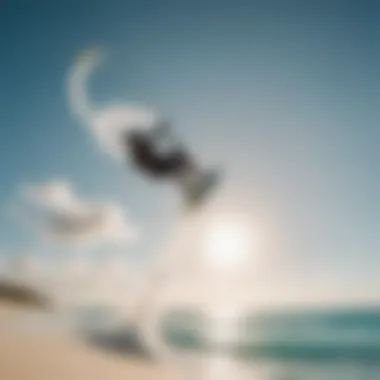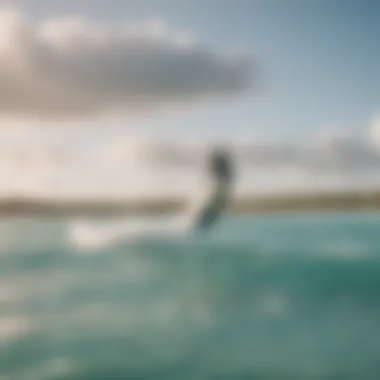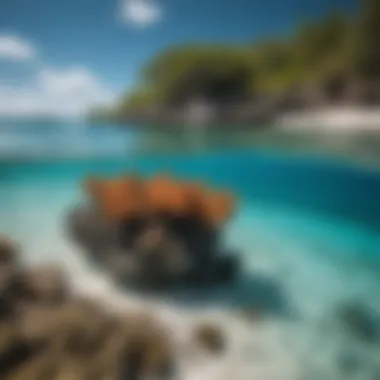Kitesurfing in Turks and Caicos: Explore the Best Spots


Intro
Kitesurfing in Turks and Caicos is not just a sport; it’s an experience that transcends the boundaries of the ocean. This Caribbean archipelago, with its serene, turquoise waters and consistent winds, offers a kitesurfing playground that attracts enthusiasts from around the globe. From novice to expert, the array of spots available caters to all levels, making it an ideal destination for anyone eager to harness the wind and ride the waves.
But there’s more to kitesurfing here than just the thrill of gliding over the water. The islands boast rich cultural heritage and breathtaking landscapes that complement the adventurous spirit of the sport. Travelers looking to dive into both kitesurfing and the unique environment of the islands will find an abundance of local knowledge and resources at their fingertips, ensuring a memorable experience that highlights the essence of this Caribbean paradise.
In the sections that follow, we’ll explore the essential surf gear required for kitesurfing, delve into techniques and skills that can enhance your performance, and also provide practical advice tailored to both newcomers and seasoned surfers. Whether you're planning a trip or simply have a keen interest in kitesurfing, this guide promises to arm you with vital information about making the most of your experience in Turks and Caicos.
Surf Gear and Equipment
To embark on your kitesurfing adventure, understanding the right gear is paramount. With the right surfboard and accessories, you can ensure a smoother experience in the water, regardless of weather conditions or your skill level.
Latest Surfboard Technologies
The landscape of kitesurfing gear has evolved significantly, incorporating advanced materials and designs that enhance performance. One notable trend is the advent of composite surfboards that combine lightweight foam with robust materials like carbon fiber. This fusion offers increased durability while keeping the board maneuverable.
Additionally, boards are now designed with specific features tailored to conditions typical of the Caribbean. For instance, some boards come with a wider outline for stability in chop, making them perfect for the variable conditions you might encounter on a breezy day. Most importantly, a surfboard's size and shape can influence your overall ride; a longer board often provides more stability, while shorter ones are better suited for tricks and fast maneuvers.
Essential Accessories for Surfers
Equipping yourself with the right accessories can make all the difference when hitting the water. Here are a few essentials that every kitesurfer should consider:
- Kites: Choose a kite designed specifically for your skill level and the wind conditions. Delta kites are particularly popular for their stability.
- Harness: A good harness helps transfer the power of the kite to your body more efficiently. Opt for a waist harness for mobility or seat harness if you prefer more support.
- Safety Gear: A helmet and impact vest are advisable for any kitesurfer. Ensuring you have adequate protection is vital as it keeps you safe while you’re learning or challenging yourself with new tricks.
- Travel Bag: Invest in a durable travel bag that can hold your kite, harness, and other equipment. Choosing a padded option can also protect your gear during transit.
By ensuring that you have the right kitesurfing gear, the experience promised by the stunning backdrop of Turks and Caicos can become all the more enjoyable.
"The right equipment doesn't just enhance performance; it gives you the confidence to explore new horizons."
The next sections will cover the techniques and skills every surfer should master to make the most out of their time on the water while enjoying the unique ecosystems of Turks and Caicos.
Foreword to Kitesurfing in Turks and Caicos
Kitesurfing in Turks and Caicos represents not merely a sport but a fusion of nature, culture, and adventure. This introduction seeks to establish why discovering this activity in the Caribbean islands is an essential experience for thrill-seekers and nature lovers alike. The islands’ unique geographical features and favorable weather patterns create a playground for both novices and seasoned kitesurfers, fostering a community that bonds over shared passion.
Overview of Kitesurfing
Kitesurfing, also known as kiteboarding, combines elements of surfing, paragliding, and windsurfing. It involves riding a small board while being pulled by a large, controllable kite. This sport isn’t just about adrenaline; it’s also about connecting with the environment. In Turks and Caicos, the combination of crystal-clear waters and endless winds creates an unparalleled kitesurfing experience. An individual can expect to glide over smooth waves while soaking in the breathtaking scenery that surrounds.
The sport itself caters to a variety of skill levels. From those who wish to take their first ride to experienced athletes looking to perfect their tricks, there’s something for everyone. Communities form around this shared interest, and kitesurfing schools offer not just lessons but a sense of belonging.
Significance of Location
The lush backdrop of Turks and Caicos is more than just visually stunning—it serves as a kitesurfing mecca. The specific geographical configuration of the islands contributes significantly to the sport's popularity. Factors such as ideal wind conditions and shallow waters create an environment that's safe and enjoyable.
When the wind begins to whistle across the horizon, it creates ample opportunities for those looking to catch some air. One of the standout features of kitesurfing here is the consistent trade winds that blow from the east, ensuring ideal conditions for much of the year. This reliability is significant for travelers who want to maximize their experience.
Moreover, the local culture embraces kitesurfing, making facilities and community support readily available for newcomers. The significance of location goes beyond just physical attributes; it reflects an ethos of adventure intertwined with a vibrant local lifestyle. Whether you're there for a week or a winter season, immersing oneself in this kitesurfing culture offers enriching experiences that linger long after the waves have settled.
"Kitesurfing is not just a sport; it's a way to connect deeply with nature and the community that thrives on these breathtaking shores."
In summation, kitesurfing in Turks and Caicos is framed within the context of its rich environment and cultural significance. This unique combination affords all participants a holistic experience that cannot be easily replicated elsewhere.
Geographical Advantages of Turks and Caicos
When talking about kitesurfing, the place you choose can make or break your experience. In the case of Turks and Caicos, the geographical advantages stand out like a diamond in the rough. These islands, adorned with stunning beaches and favorable weather, create an environment that is not only inviting but also quite perfect for kitesurfers of any skill level. From the wind patterns to the tranquil waters, the geographical features here are essential for anyone looking to ride the waves.
Ideal Wind Patterns
The winds in Turks and Caicos are often considered one of the primary lures for kitesurfers. On a typical day, the trade winds blow steadily around 15 to 30 knots. This wind pattern doesn’t just pop up randomly; it’s a seasonal gift, particularly from November to April.
These winds come from the east, making the north-eastern shores particularly favorable. Places like Long Bay Beach often have a consistent wind that’s ideal for both beginners and experienced kitesurfers. The patterns might feel like they have a mind of their own sometimes, but familiarizing yourself with how these winds behave can translate into a smoother, more enjoyable ride.
- Why Wind Matters:
- More wind equals better lift for those tricks you want to pull off.
- A consistent breeze helps even novice riders find their footing.
- Less hassle with planning; you’re more likely to be able to kite on most days.


Water Conditions and Safety
Ah, the water! In Turks and Caicos, it’s like a painter’s palette with shades of blue that many can only dream of. The water condition is just as important as the wind. The beaches here are typically surrounded by shallow, turquoise waters, which not only makes for stunning views but also provides safer riding conditions.
The shallow depths mean that even if you take a tumble, the water is often belly-button level, making recoveries easier. Moreover, the beaches tend to have soft sand, reducing the risk of injury during falls.
"Riding these crystalline waters is akin to gliding over glass, an experience unlike any other."
However, keep in mind that safety’s always a tops priority. Kitesurfers need to be well-versed in their environment to avoid hidden challenges, which can include coral reefs and currents that pick up strength. Be mindful of the following:
- Safety Precautions to Consider:
- Always check local conditions before heading out.
- Stay clear of reef areas to avoid damage to both your equipment and yourself.
- Use a buddy system; kitesurfing is much safer when you have eyes watching your back.
In summary, the geographical advantages of Turks and Caicos come together to create a kitesurfing haven. The interplay of consistent winds and safe, beautiful waters makes it a must-visit destination for anyone in love with the sport.
Popular Kitesurfing Spots
When it comes to kitesurfing, not all beaches are created equal. Some locations magically blend geography, wind conditions, and water clarity, making them prime spots for riders of all levels. This section focuses on the most notable kitesurfing areas in Turks and Caicos, offering insights into why these places stand out. Not only does each location boast its unique flavor, but they also cater to various skill sets, ensuring everyone finds their groove.
Long Bay Beach
Long Bay Beach, often referred to as a hidden gem, features stunning turquoise waters and consistent winds that attract kitesurfers year-round. The beachfront stretches out, allowing for ample space even when the tides bring in enthusiasts from all corners. Here, the landscape provides a serene backdrop where riders can float through the air while taking in the awe-inspiring views.
The shallow waters also contribute to safety, particularly beneficial for beginners who might still be finding their balance on the board. Long Bay Beach is known for its gentle waves, making the learning process feel less daunting. Effective instruction is available at local schools, with instructors who know the area like the back of their hand. Moreover, the beach environment is quite laid back; it fosters a communal vibe among kitesurfers, everyone exchanging tips and sharing experiences without hesitation.
Half Moon Bay
Half Moon Bay delivers another layer to the kitesurfing narrative in Turks and Caicos. The notable crescent shape of the bay gives it a unique wind pattern, creating a dynamic kitesurfing environment. Riders often admire the breathtaking scenery while navigating through soft waves. The location can be particularly favorable on days when winds shift due to its strategic position between uplifted landforms.
What makes Half Moon Bay noteworthy is its versatility. Both adventurous riders and novices can find their spot here. The beachfront is wide enough to accommodate a mix of abilities. It’s not uncommon to see seasoned kitesurfers performing tricks in one corner, while beginners practice their take-offs on the other end. Further, visiting during windy seasons can elevate the experience, pushing more adrenaline enthusiasts to test their skills against the challenging elements that this bay can offer.
Sapodilla Bay
Sapodilla Bay is a different flavor altogether. It is beloved for its calm and shallow waters, making it an ideal location for families and beginners. Imagine gliding over a smooth surface with hardly any interruptions—this is the essence of Sapodilla Bay. The calm waters make way for steady winds, which means that kitesurfers can enjoy extended sessions without the usual obstacles. Importantly, this bay’s environment fosters a relaxed atmosphere, where one can find peace amid the playful challenge that kitesurfing offers.
Safety remains a prime concern for anyone engaging in water sports, and Sapodilla Bay stands out in this regard. Lifeguards patrol the beaches, and ensuring the protection of all riders is a community effort. Newer participants can engage with schools offering guided lessons, which cater specifically to the gentle nature of the bay. Plus, the scenic beauty surrounding the bay creates a picturesque backdrop, enhancing the overall kitesurfing experience. In fact, many share that one session here can leave lasting memories.
"Exploring the various beaches can open up new ways to enjoy kitesurfing. Each spot offers unique challenges and beauty, bridging the gap between skill improvement and the joy of nature."
Skill Levels and Kitesurfing
Understanding the different skill levels in kitesurfing is crucial for both novices and seasoned riders alike. Each person’s journey into this thrilling sport varies, but a solid grasp of where one stands on the skill spectrum can greatly enhance the experience. For beginners, diving into kitesurfing can feel like climbing a mountain – daunting at first, but the view from the top is worth every bit of effort. For more advanced surfers, recognizing the challenges of their surroundings can make the difference between a good day on the water and a great one.
In Turks and Caicos, kitesurfing conditions cater to all sorts of riders. The significance of understanding skill levels ensures safety, enjoyment, and ultimately, improvement in technique. Evaluating where one fits into the puzzle not only prepares the rider for what to expect but also helps them choose the right spots and gear.
Beginner-Friendly Locations
For those just starting out, Turks and Caicos features an array of spots that provide both calm waters and gentle winds. Places like Long Bay Beach, with its shallow waters, offer a perfect playground for novices. Here, you can practice the basics without worrying about strong currents or large waves. The clear turquoise water allows for easy visibility, which helps inexperienced riders spot any potential hazards beneath the surface.
Some key beginner-friendly areas include:
- Long Bay Beach: Ideal for its shallow depths and consistent winds.
- Sapodilla Bay: A perfect tranquil spot that encourages beginners to hone their skills with minimal interruptions.
These locations not only provide a safe environment but also feature rental shops and schools offering lessons tailored to new kitesurfers.
Advanced Kitesurfing Conditions
For the more seasoned kitesurfers itching for a challenge, Turks and Caicos has that too. Half Moon Bay offers conditions that suit high-skilled riders looking for stronger winds and wave action. It's where adrenaline kicks in; however, caution is advised, as the varying conditions demand a solid skill set and an understanding of the sea.
When planning a session at one of these advanced locations, keep in mind:
- Wind patterns: Knowledge of local wind patterns provides insight into the best times to hit the water.
- Obstacles: Awareness of underwater structures helps avoid collisions or tricky takeoff issues.
- Tides: Understanding tidal changes can make or break your kitesurfing session. Falling into a groove of advanced kitesurfing builds not only your confidence but also your repertoire of techniques.
With that said, the waters off Turks and Caicos cater to a full spectrum of kitesurfing enthusiasts, ensuring that both beginners and advanced riders find their niche in this paradise. As they say, 'practice makes perfect' and with the right conditions, performers of all levels can both learn and grow.


"Kitesurfing isn’t just about riding waves; it’s about understanding nature and pushing your limits."
Without a doubt, entering the realm of kitesurfing in Turks and Caicos offers a unique array of possibilities, making sure that every rider, regardless of skill level, can find their way into this exhilarating sport.
Kitesurfing Schools and Rentals
Kitesurfing in Turks and Caicos offers not just thrilling wind and water experiences but also a chance to learn the sport properly. Engaging with local kitesurfing schools and renting equipment holds significant importance for both beginners and seasoned surfers. Education plays a vital role in enhancing safety and technique. Even the most experiencedw surfers can benefit from lessons that introduce them to the unique conditions of the Caribbean waters. By opting for local schools, enthusiasts not only ensure they learn from those familiar with the area but also support the local economy. The facilities and resources available to renters are usually top-notch, ensuring a seamless experience.
List of Reputable Schools
When looking for credible kitesurfing schools, quality of instruction and safety protocols are paramount considerations. Here’s a list of some reputable schools that come highly recommended by past students and local adventurers:
- Big Blue Unlimited: Located in Providenciales, they offer a range of lessons from beginner to advanced levels, all with safety as a priority. Their instructors are certified and well-versed in the local waters.
- Turks and Caicos Kiteboarding School: A favorite among tourists, this school provides tailored lessons and has a solid reputation for creating confident kitesurfers in a short amount of time.
- KiteProvo: This school offers group and private lessons, ensuring personalized attention. They are recognized for their commitment to customer satisfaction and ensuring students feel welcome.
- Ocean Vibes: Known for a relaxed atmosphere alongside professional instruction, they cater well to families and smaller groups. They also emphasize environmental responsibility within their lessons.
Each of these schools boasts certified instructors and equipment, giving peace of mind that safety and learning are at the forefront of their services.
Equipment Rental Options
If you are not ready to invest in personal kitesurfing gear, renting equipment is a smart option. Many local shops and centers provide high-quality gear for all skill levels. Here are some considerations for rental options:
- Variety of Gear: Rentals typically include kites, boards, harnesses, and safety equipment. Most shops possess a range of brands and models, allowing surfers to try different styles.
- Daily or Weekly Rates: Depending on your stay length, rental shops often provide flexible pricing. Some offer discounts for longer rentals, so it’s worth asking.
- Condition of Equipment: Before committing, inspect the gear's condition. Quality shops will provide well-maintained equipment, ensuring a safe and enjoyable ride.
- Pick-Up and Drop-Off Flexibility: Some schools offer convenient pick-up and drop-off services, making logistics easier for travelers.
- Insurance Options: Check if the rental includes liability insurance or if it’s available for purchase. This can make a huge difference if something goes amiss on the water.
Safety Practices in Kitesurfing
Kitesurfing may tap into the thrill-seeker in all of us, but without proper safety protocols in place, it can quickly transform from an exhilarating activity into a hazardous pursuit. The beauty of Turks and Caicos lures many adventurers, yet understanding safety practices is essential for enjoying this sport while minimizing risks. Emphasizing safety ensures kitesurfers experience the joy of the winds and waves without the looming threat of potential accidents.
Essential Safety Gear
Equipping oneself with the right safety gear is not just prudent; it’s necessary. Below are key pieces of equipment to consider:
- Helmet: Protecting the head from potential impacts is crucial. A well-fitted helmet can prevent serious head injuries.
- Impact Vest: This addition not only offers buoyancy if you fall but also provides cushioning against the board or water impact.
- Harness: A comfortable and secure harness keeps you connected to the kite, allowing better control and reducing strain on your arms.
- Safety Leash: An essential piece designed to detach your kite from you in emergencies, preventing it from dragging you through the water.
- Life Jacket: While many kiteboarders are excellent swimmers, a flotation device ensures extra security, especially in rough waters.
Using high-quality equipment is non-negotiable. Make sure to choose gear suited to your skill level and body type. It’s not just about being stylish on the water—protection is paramount.
How to Handle Adverse Conditions
Adverse conditions can sneak up on even the most seasoned kitesurfers, making it essential to know how to respond. Recognizing the signs of changing weather is crucial. Here’s how to navigate those rough patches:
- Stay Informed: Before hitting the water, check weather forecasts and wind conditions. Reliable apps and local advice can help gauge what to expect.
- Know Your Limits: If winds exceed your skill level, or the waves seem too daunting, don’t hesitate to sit it out. There will always be another day.
- Emergency Procedures: Familiarize yourself with local emergency contact numbers and protocols. Knowing how to signal for help can make a world of difference.
- Use Good Judgment: If you find yourself in the water and conditions worsen, ride back to shore when possible. It’s better to reassess than to risk injury.
"Safety doesn’t come from luck. It comes from being prepared."
For kitesurfers, the waters are not just a playground; they demand respect and caution. Awareness and proper gear combine to create a safer experience, allowing everyone to fully appreciate everything that kitesurfing in Turks and Caicos has to offer.
Environmental Considerations
Kitesurfing in the idyllic setting of Turks and Caicos isn’t just about the thrill of gliding over turquoise waters; it’s also intertwined with significant environmental considerations. As kitesurfers flock to these stunning islands, understanding the impacts on local ecosystems is crucial. Notably, these considerations help ensure that this beautiful destination remains a vibrant haven for both water sports enthusiasts and the rich marine life it sustains. Here are the essential aspects to ponder:
- Preserving Natural Habitats: Kitesurfing can disrupt local wildlife, particularly in areas where nesting birds or vulnerable marine species thrive. Kitesurfers should remain mindful of their surroundings and respect designated wildlife areas.
- Waste Management: Often, the excitement of kitesurfing leads to waste that, if not managed properly, can find its way into the waters or onto beaches. Striving for a litter-free environment not only enhances the beauty of the beaches but also protects the ecosystems beneath the surf.
- Sustainable Practices: Promoting sustainable practices within the kitesurfing community is paramount. This can encompass everything from choosing eco-friendly equipment to collaborating with local organizations that prioritize environmental health.
"We must remember that our enjoyment of kitesurfing depends on the health of our natural surroundings. The waters and winds that invigorate our passion for the sport are part of a delicate balance that deserves our utmost respect."
Impact of Kitesurfing on Local Ecosystems
Kitesurfing, by nature, involves interacting closely with marine environments. However, the impact it can have on local ecosystems is nuanced and deserves careful attention. For instance:
- Erosion of Coastal Areas: Repeated use of certain kitesurfing spots can lead to the erosion of beaches. This can destabilize the coastline and lead to loss of habitats for various species.
- Disruption of Marine Life: The noise and movement from kitesurfing gear can disrupt the livelihoods of marine species, particularly during breeding seasons. It's important to be conscious of these aspects to help maintain biodiversity.
- Coral Reefs: The areas around Turks and Caicos feature delicate coral reefs. Careless maneuvering or crashes can damage these critical ecosystems. Therefore, kitesurfers should be educated on best practices to minimize their impact on these fragile environments.
Conservation Efforts in Turks and Caicos
As awareness of the environmental impacts rises, so do the local conservation efforts dedicated to preserving the beautiful ecosystems of Turks and Caicos. Various initiatives are in place, engaging both locals and visitors to contribute positively:
- Educating Kitesurfers: Many kitesurfing schools include environmental education in their curriculum, emphasizing the importance of maintaining ecological balance. Knowledge fosters responsibility.
- Collaborative Projects: Local organizations often work hand-in-hand with kitesurfing communities to promote beach cleanups and marine conservation efforts. These partnerships yield visible benefits, from cleaner beaches to healthier marine populations.
- Protected Areas: The establishment of marine protected areas ensures that certain regions are shielded from the adverse effects of water sports. These areas help sustain fish populations and preserve crucial marine habitats for generations to come.
Conservation is not just a buzzword; it represents a shared responsibility. As kitesurfers enjoy the splendors of Turks and Caicos, there’s also a collective duty to preserve its natural beauty for those who will ride the winds in the future.


Cultural Aspects of Kitesurfing
Kitesurfing in Turks and Caicos is not just about the thrills of wind and waves; it's deeply intertwined with the local culture. As this sport gains popularity, it becomes a part of the social fabric, shaping interactions among enthusiasts, diversifying tourism, and fostering community bonds. Understanding these cultural aspects can enrich the kitesurfing experience and provide valuable insights into the local way of life.
Local Community Involvement
The involvement of the local community in kitesurfing is multifaceted. Firstly, many residents have embraced the sport, establishing informal groups where they share tips and experiences. This grassroots engagement creates a welcoming atmosphere for newcomers. Locals often serve as instructors, offering knowledge that goes beyond technique, encompassing respect for the environment and local customs.
In addition, kitesurfing has bolstered the local economy. Small businesses and vendors often pop up around kitesurfing hotspots, providing everything from equipment rentals to snacks for hungry riders. Supporting these establishments fosters an interdependent relationship between tourists and the community, emphasizing a mutual respect.
Moreover, many islanders have started organizing community-based events that encourage participation in kitesurfing while promoting local culture, like beach clean-ups followed by kitesurfing sessions. This kind of local involvement not only strengthens community ties but also raises awareness about the environmental impact of water sports.
Festivals and Events
The kitesurfing scene in Turks and Caicos is enlivened by vibrant festivals and events, celebrating the sport and its cultural significance. These gatherings are not simply competitive; they are a showcase of unity, creativity, and passion.
Annual events like the Turks and Caicos Kitesurfing Invitational draw both locals and tourists. Enthusiasts gather to compete, share stories, and showcase their talents in freestyle and racing formats. The atmosphere is electric, a blend of exhilarating performances and camaraderie. Spectators applaud the skill displayed, while vendors offer local delicacies and kitesurfing gear.
Additionally, music and dance play a significant role in these festivities. Many events include live performances from local artists, bringing the community together in celebration. The mix of sport and culture creates a dynamic environment where participants can revel in their shared love for kitesurfing and reveal their heritage.
"In Turks and Caicos, kitesurfing isn't just about catching air; it's about catching the spirit of the island!"
Altogether, the cultural aspects of kitesurfing add depth to the experience in Turks and Caicos. From community involvement that fosters lasting relationships to lively festivals that celebrate life and sport, every breeze carries the essence of the islands.
Travel Tips for Kitesurfers
Kitesurfing is not just a sport; it's an adventure that beckons you to the open waters of Turks and Caicos. Whether you're a seasoned kiteboarder or a curious newbie, having some savvy tips up your sleeve can make all the difference. In this section, we’ll walk through key advice on planning your kitesurfing trip. This isn’t just about catching the perfect wave; it’s also about maximizing your experience both on and off the water.
Best Time to Visit
Timing is crucial when it comes to kitesurfing in the Caribbean. The wind patterns vary throughout the year. Generally, the prime kitesurfing months in Turks and Caicos fall between November and July, with the most consistent winds blowing from the east. Here’s a breakdown of what you can expect:
- November to March: This period offers strong winds and mild temperatures, making it a favorite among the kitesurfing community. However, be prepared for larger crowds, as many enthusiasts flock here during winter.
- April to July: Winds remain steady but can be milder. This time sees fewer tourists, giving you ample space to practice. However, take caution as occasional storms can appear in late summer.
While less favorable conditions can be found outside these months, such as during hurricane season, those who are well-prepared can still find enjoyable spots.
Accommodation Options
Finding the right place to stay can truly enhance your kitesurfing experience. In Turks and Caicos, you have a range of accommodations that cater to all budgets. Some popular options include:
- Resorts: Try Grace Bay Club or Beaches Resort. They offer direct beach access with facilities for kitesurfers, including rentals.
- Boutique Hotels: Places like The Inn at Grace Bay give a more unique feel with personalized services.
- Vacation Rentals: For those who prefer more living space and kitchen facilities, consider vacation rentals through platforms like Airbnb. This can be a more cost-effective solution, especially for groups.
- Hostels: For the backpackers or budget-conscious, there are comfortable hostels where you can meet fellow travelers.
By aligning your accommodation with your kitesurfing needs, you’ll ensure that returning from a day on the water is relaxing and rejuvenating.
Transport and Logistics
Getting around Turks and Caicos can be a breeze with the right planning. Here are some handy tips:
- Car Rentals: The islands are relatively small. Renting a car or scooter is often the best choice to explore various kitesurfing spots at your own pace. Local companies like Bungalow Rentals are reliable options.
- Public Transport: Though limited, taxis and shuttle services can get you around, especially from the airport to your accommodation. Always check for shared ride options to save money.
- Packing Your Gear: Make sure to check the baggage policies of your airline regarding kitesurfing equipment. Consider investing in a good quality travel bag that can protect your gear during transit. Heading to the shores with the right tools at your disposal can take your adventure to another level.
"Planning is everything. The right timing, accommodations, and transport can elevate your kitesurfing escapade from average to unforgettable."
When you keep these travel tips in mind, kitesurfing in Turks and Caicos transforms into a seamless and exhilarating experience. Integrate these insights into your plans for a trip that balances thrill on the waves with comfort and convenience on land.
Ending
In wrapping up this exploration of kitesurfing in Turks and Caicos, it's clear that this beautiful destination offers much more than just picturesque beaches. The significance of kitesurfing here is deeply intertwined with the wind rhythms and ocean currents that have drawn adventure seekers from around the world. This sport not only promotes a thrilling experience but also fosters a connection between the participant and the breathtaking natural landscape.
Summary of Key Insights
Taking a moment to reflect, several key aspects emerged:
- Geographical Advantages: The unwavering trade winds and crystal-clear waters create a kitesurfing utopia that is both safe and exhilarating. Ideal locations cater to a variety of skill levels, ensuring everyone has a place to ride the winds.
- Cultural Context: The local communities embrace kitesurfing, showcasing a culture rich in collaboration and shared experiences. Engaging with the locals can enrich one's journey, adding layers to the mere act of navigating the waves.
- Environmental Awareness: It’s vital to appreciate the ecological implications of kitesurfing. Understanding how this sport interacts with the delicate ecosystems of the islands can help promote sustainable practices among enthusiasts and encourage conservation initiatives.
Final Thoughts on Kitesurfing in Turks and Caicos
As we ponder the essence of kitesurfing in Turks and Caicos, it becomes apparent that this voyage extends beyond the thrill of catching air and carving through waves. It is about cultivating an appreciation for nature, embracing camaraderie with fellow riders, and respecting the landscapes that host such adventures. For every kite that touches the sky, there’s a story and a connection to the ocean below.
Therefore, whether you are a seasoned kitesurfer or a curious traveler contemplating your first ride, Turks and Caicos stands as an ideal launch pad for your adventures. Every gust of wind and wave that rolls in invites you to explore not just the waters, but also the cultural richness and enchanting beauty of these islands.
“In every wave of the ocean lies the heartbeat of an adventure waiting to be discovered.”
Ultimately, embracing this fascinating sport in such a stunning locale offers not just adrenaline but also a journey toward personal growth and environmental stewardship. Let the winds guide you as you embark on your kitesurfing adventure in this Caribbean paradise.















